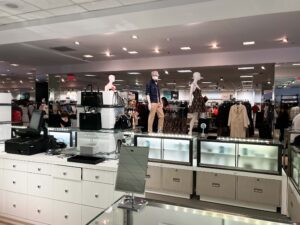
What does the proposed $2.65 billion acquisition of Neiman Marcus by Hudson’s Bay Co. (HBC), parent company of Saks Fifth Avenue – seven years in the making and still to be approved by the Federal Trade Commission (FTC) – mean for the stores, employees and customers in Westchester and Fairfield counties?
Not much physically but perhaps a whole lot existentially down the road.
According to The Washington Post, there are no plans for store closures, which may be good news for many of the 10,000-plus employees of the 41 Saks Fifth Avenue stores and the 100 Saks Off Fifth discount outlets, along with an equal number of employees at the 36 Neiman Marcus stores, its five Last Call discount outlets and the two Bergdorf Goodman stores in Manhattan, situated just north of the Saks Fifth Avenue flagship. That’s not to say that some closures might not be tempting as the stores, comprising the new Saks Global, represent $7 billion worth of retail real estate.
And maintaining the stores – nearly half of which are within walking distance of each other – and their overlapping brands will be complex, writes Forbes senior contributor Steve Dennis, once part of Neiman Marcus’ executive leadership team. That shouldn’t be a problem in our area, as Neiman Marcus is at The Westchester mall in White Plains, 21 miles from The Saks Shops at Greenwich. (The three local Saks Off Fifth outlets, in White Plains, Eastchester and Stamford, appeal to a different clientele. More on that in a bit.)
Where the sting will be felt, Dennis writes, is in the gutting of the Neiman Marcus Group leadership as the focus shifts from Dallas, where the store was founded 116 years ago, to New York City, where Saks established a base in 1902 after its founding in Washington, D.C., in 1867. Note that Saks Global will be run by Saks CEO Marc Metrick.
But the real question in all this is, Whither luxury? It’s no secret that Neiman Marcus and Saks have encountered the challenges of all brick-and-mortar brands in the age of online shopping, which have been compounded by inflation. Neiman Marcus filed for Chapter 11 protection in the pandemic year of 2020 but reemerged after debt reduction ($4 billion) and refinancing. Last November, Saks had to look to its real estate holdings to make $340 million in late payments to vendors, while in April, Saks.com raised $60 million from Pathlight Capital and Bank of America to cover sagging sales. (A July 12 visit to Neiman Marcus Westchester and its Mariposa restaurant – with its still enjoyable blend of comforting classics and new offerings – found the foot traffic light.)
So is the merger about holding on or doubling down? Here is part of the July 4 announcement from Richard Baker, executive chairman and CEO of HBC, a Canadian-American retail group that was originally chartered in London in 1670 as a fur-trading company:
“This is an exciting time in luxury retail, with technological advancements creating new opportunities to redefine the customer experience, and we look forward to unlocking significant value for our customers, brand partners and employees.”
No doubt this is where minority investors Amazon and Salesforce Inc., a software company, come in. It’s ironic that Amazon, whose fast delivery of goods, has been partly credited with the demise of brick and mortar, should now be counted on to help Saks Global deliver curated luxury to shoppers in the age of AI.
But what about those shoppers? Well, there are two schools of thought on this. On the one hand, luxury is said to be recession-proof as the rich can afford to pay for what they want. But Fashion Institute of Technology professor Shawn Grain Carter told The Washington Post that only about 60% of sales at luxury stores come from households earning more than $200,000 a year. That means luxury stores must also count on the so-called aspirational shoppers.
And they’re out there, including at Saks Off Fifth, whose Eastchester and Stamford homes are in the former sites of the late, lamented Lord & Taylor, once owned by HBC; and on TikTok, where aspirants of quiet luxury have adopted the late Calvin Klein publicist Carolyn Bessette-Kennedy as their minimalist muse.
It’s not just the brands of the new Saks Global that are looking for these shoppers. As we reported in March, Macy’s, while shuttering about 150 “unproductive” stores nationwide, is investing in more resources in some 350 “go-forward” locations and expanding its Bloomingdale’s and Bluemercury footprints in up to 45 locations – all through 2026 in a bid to up its luxury game.
These retailers are betting on aspirational shoppers – and on the idea that luxury goods and experiences are not just a luxury in today’s lifestyle.



















